On July 30th, 2020, we listed the Global X Telemedicine & Digital Health ETF (EDOC). EDOC seeks to invest in companies that are well-positioned to benefit from further advances in the field of Telemedicine and Digital Health, including companies involved in telemedicine, connected health care devices, health care analytics, and administrative digitization.
Telemedicine and Digital Health has received significant attention throughout the ongoing COVID-19 pandemic. With large swaths of the global population under stay-at-home orders, technology-based tools that facilitate remote communication with doctors and enable patient monitoring became critical.1 Some U.S. health care providers report that telehealth visits, defined as consultations in which a patient connects with a doctor via voice or video chat, increased by as much as 175x since the pandemic began.2 Additionally, the strain the pandemic put on all aspects of the global health care system highlights broader opportunities to modernize health care by more effectively leveraging technology and digitization.
Despite the recent attention directed at this theme, we believe the long-term paradigm shift in health care toward digitization is still in its early stages and is driven by several underlying factors:
- Unequal access to health care across demographics and geographies highlights opportunities for technology to expand the industry’s reach. To this point, 15.6M excess deaths occurred in low- and middle-income countries in 2016, 55% from inadequate care and 45% from non-utilization of health care.3
- People are living longer, and populations are getting older. Life expectancy rates grew faster from 2000 to 2016 than in any period since the 1960s.4 And by 2100, 28% of the global population could be over the age of 60, compared to just 13% in 2017.5 Older populations have greater health care needs and health care providers will need to innovate to treat those patients effectively and efficiently.
- Inefficiency and stagnation in global health care systems result in sub-optimal outcomes for both health providers and patients. The OECD estimates that $1.3 trillion, or 20% of annual health care expenditures in OECD countries comes from systemic inefficiencies that include administrative complexities, pricing failure, redundancies, and fraud.6
- Increased connectivity makes the delivery of virtual health services possible. Today, there are 4.6 billion active internet users globally.7
In our view, these trends are driving significant opportunity in telemedicine and digital health – the market for these technologies reached an estimated $175 billion in 2019 and is expected to grow to over $657 billion by 2026.8 In the following piece, we explore how this growth might be achieved.
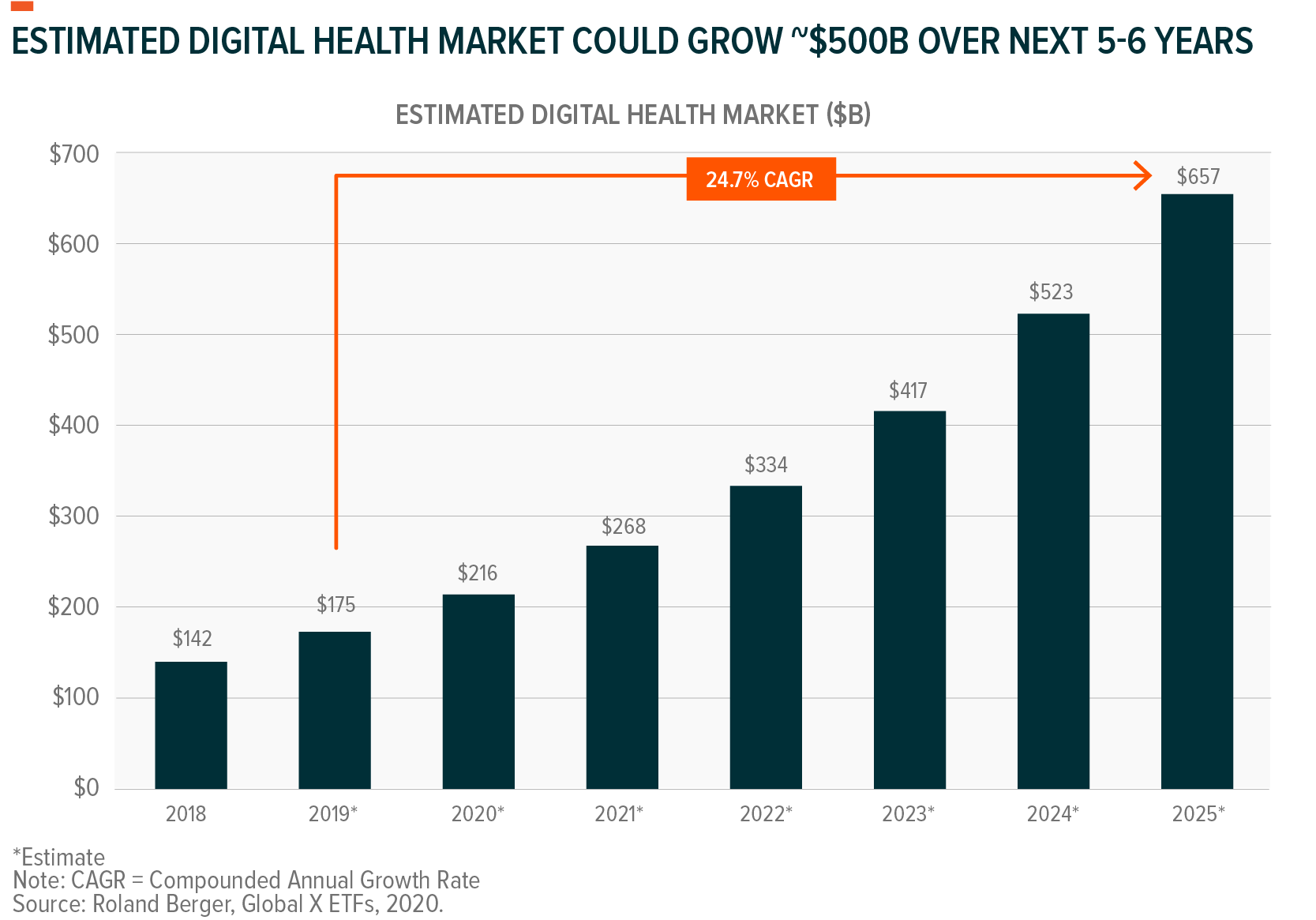
Expanding Health Care’s Reach
Half of the global population lacks access to essential health services.9 A portion of this is attributable to geographic location and physical distance from health care resources and/or professionals. Telemedicine can help expand essential care to these individuals.
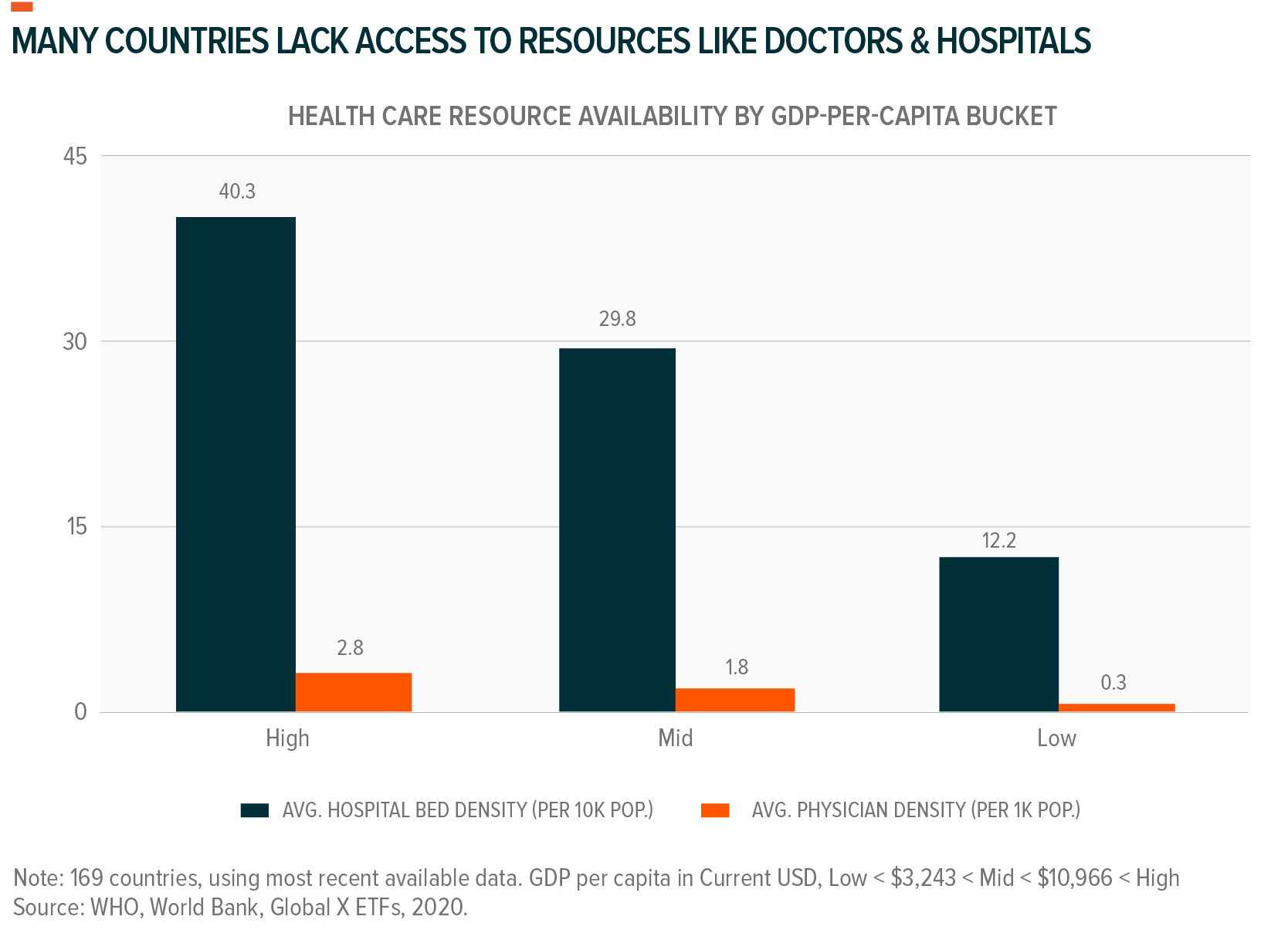
Rural areas in the U.S., which saw 120 hospitals closures since 2010, have welcomed telemedicine and seen early successes.10 According to a recent survey conducted by NPR, 24% of rural adults indicated use of telehealth, with 90% of those individuals noting satisfaction with the service.11 To the benefit of both individuals and health care systems, rural telemedicine adoption can limit the number of emergency room transfers from rural to more developed areas.12 Previous limitations to these services included lack of broadband access, but the FCC’s July 2020 commitment of $200M to improve rural telehealth infrastructure should prove to be a tailwind to these services, as should broader rollouts of high speed internet and 5G technology.13
Similar opportunity for the technology lies in even more remote locations around the world. In sub-Saharan Africa – where skin ailments are common, but dermatologists are scarce – researchers established a mobile teledermatology service. Through their work, they diagnosed 49% of patients seen with inflammatory skin diseases and received positive feedback from 81% of local health care workers.14 Doctors Without Borders similarly implemented a telemedicine program in Somalia and, in one year’s worth of tele-consults, found that 56% of those consults added significant diagnoses and 25% caught life-threatening conditions.15 While many of these remote areas lack the connectivity infrastructure for full scale deployment of this technology as of now, global internet adoption continues to rise.
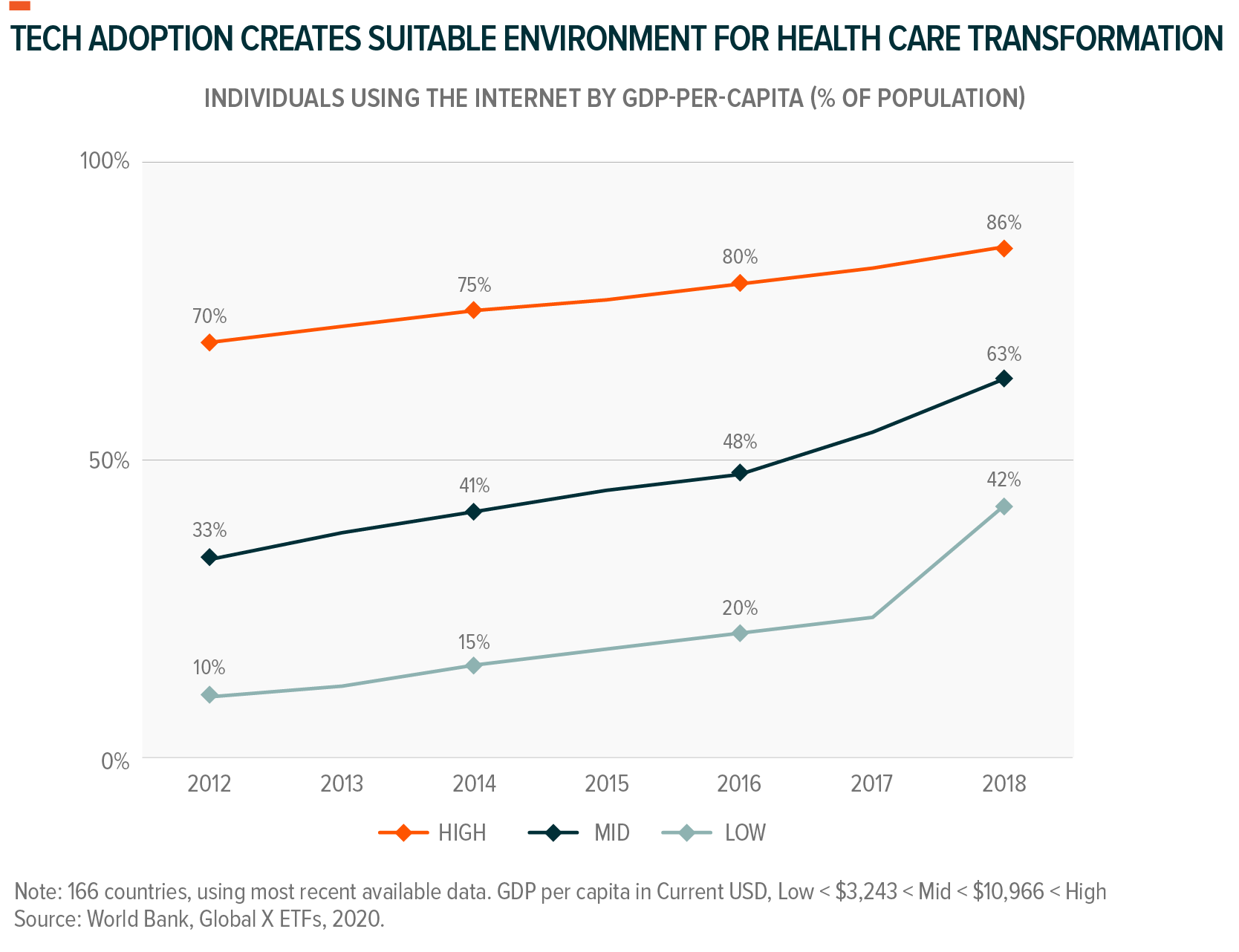
Economic constraints also contribute to individuals forgoing medical treatment. In OECD countries, 17% of adults indicate that financial considerations contribute to their unmet medical needs. Telemedicine can play a role in reducing these costs. In the U.S., health insurance provider Anthem reduced its co-pay for telehealth visits to $5, a stark contrast to the $25-35 charged for in-person primary-care visits.16 The immediate value from a one-off consultation is apparent, but the compounding cost-savings from ensuing follow-ups could result in savings that could positively affect patients’ indifference curves for seeking health care. In all, the U.S. Veterans Health association estimates $6,500 annual savings for each patient participating in telehealth.17 Additional savings can come from minimized travel costs. Between 1996 and 2013, the University of California Davis Health System found that telemedicine saved its patients $2.9 million of total direct travel costs and 9.0 years of transit time.18 And although affordability means lower per-use service costs for providers, the incentives presented by overall cost-savings, convenience, and meeting unmet needs drives usage and adoption, potentially more than making up for any lost revenue.19
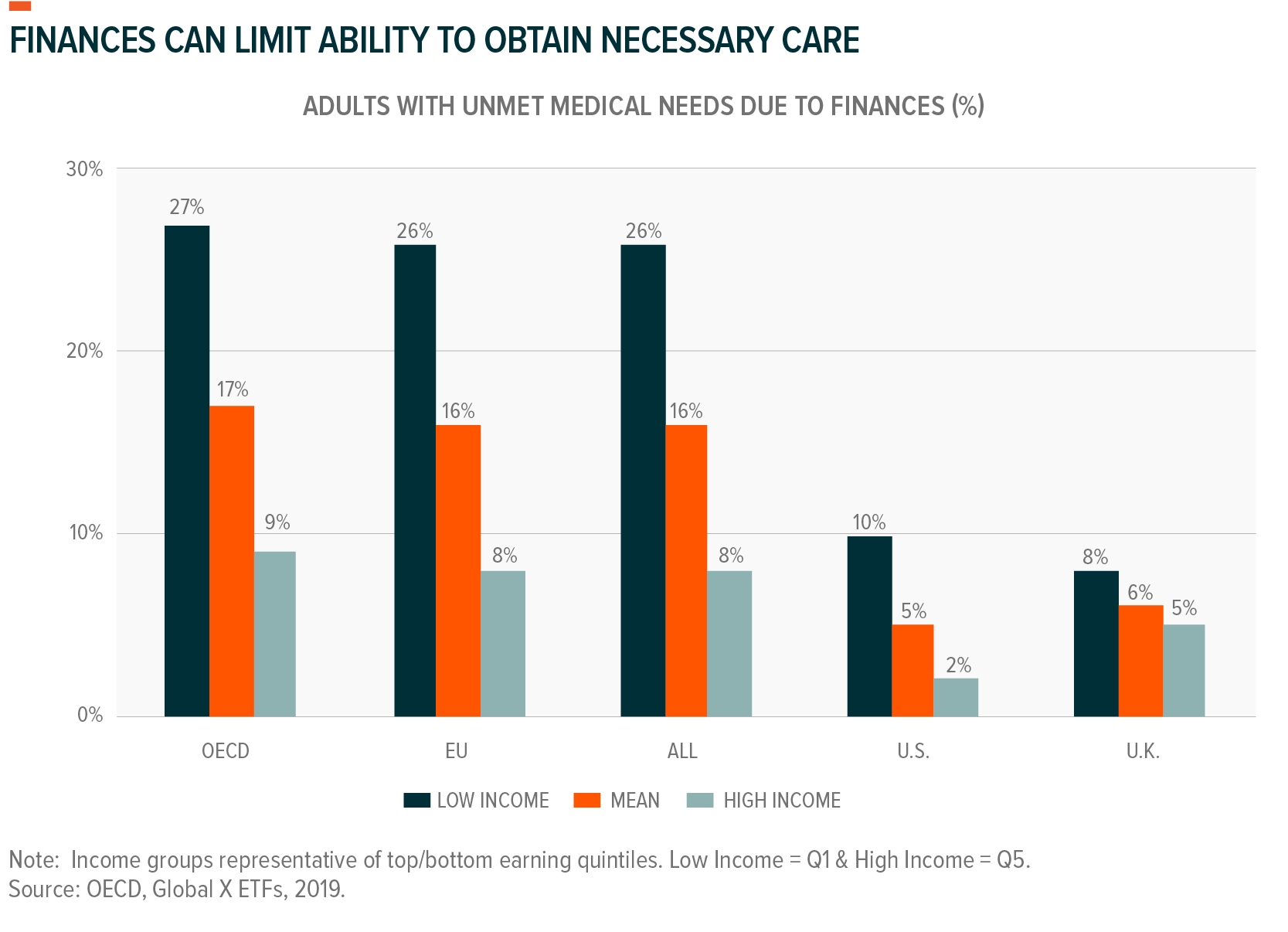
Smart Treatments and Better Outcomes
Digital health tools are revolutionizing the ways that providers care for patients, delivering novel solutions to enhance health outcomes across a variety of areas. Treatment adherence, or patients’ ability to follow through with medical advice and care, is one such area.
Treatment adherence is widely known as a primary impediment to the effective provision of care – less than 50% of patients demonstrate full adherence to provider-directed regimens.20 Some studies show that non-adherence causes around 125,000 deaths and up to 25% of U.S. hospitalizations each year.21 Telemedicine offers a potentially effective solution, by making communication with doctors more convenient and less expensive. This can prove especially valuable for chronic illnesses that require constant monitoring.
Sufferers of chronic heart failure (CHF), for example, require dynamic risk identification and timely intervention to manage their condition. In an analysis of congestive heart failure studies, researchers found that patients using telemedicine saw mortality decreases ranging from 15% to 56% compared to those not using telemedicine (across 18 of the 19 studies reviewed).22 A separate study looked at the efficacy of telemedicine in enforcing medication adherence in patients with severe mental illness. Results showed that after six months, the patient cohort using telemedicine was far more likely to be medication-adherent.23
Internet-of-Things (IoT) medical devices, connected wearables, and self-reporting mobile health applications further close the physical distance between providers and patients, allowing for monitoring away from traditional points of care. In 2017, the FDA approved an ingestible sensor-equipped pill to treat schizophrenia, mania, bipolar I disorder, and depression in adults. The pill syncs up to a wearable patch, which then communicates with a smart phone to yield information around ingestion that can be useful to patients and providers.24
Beyond adherence monitoring, such technology can give doctors valuable information around their patients’ health from afar. Remote intensive care units (eICUs) contain myriad connected devices ranging from cameras, ventilators, and monitoring systems that track vitals like temperature, SpO2, ECG, heart rate, blood pressure, and more. Data shows that these centers can contribute to a 15-60% reduction in mortality and can reduce average stay time by 30% on average.25
On a smaller scale, self-administered connected medical devices can give doctors similar information, while also empowering patients with control over their own care. This is especially valuable when it comes to treating lifelong chronic conditions like diabetes 1. In the past, this condition required attentive monitoring of blood sugar levels and management of insulin administration. But today, devices like IoT-equipped continuous glucose monitors (CGM) and insulin pumps can make the process mostly hands off, automatically checking blood sugar levels, delivering predictively dosed medication, and organizing health data in an accessible way.26
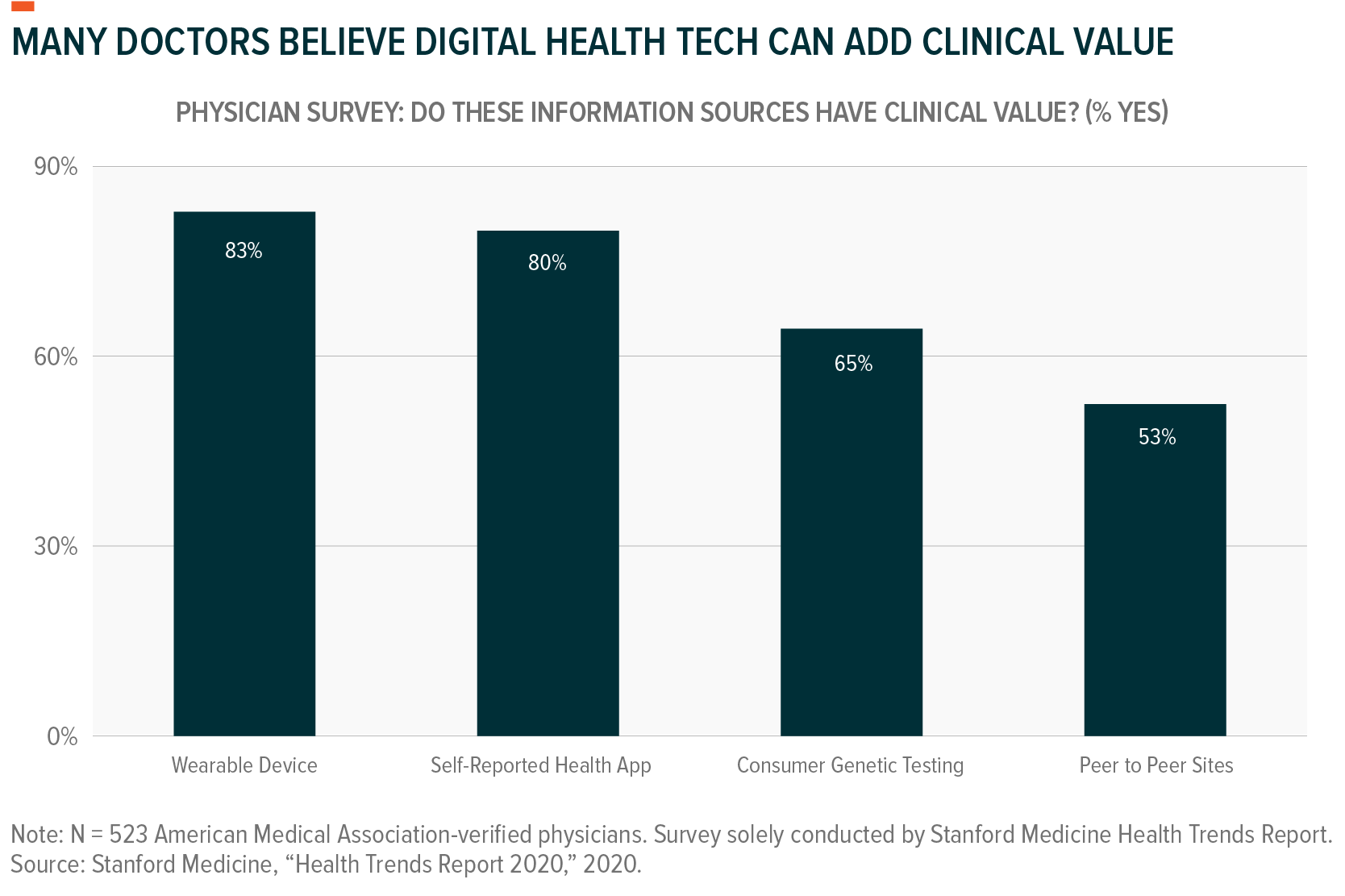
Data from these devices, health applications, and other sources can offer preventative health benefits when paired with genomic information and data from the broader health community. Artificial intelligence (AI) can put this data to use, finding patterns that can lead to precision treatments and smart diagnoses. By January 2020, the FDA approved over 60 different AI algorithms for medical treatment. These mostly included algorithms that analyze medical scans and images, including ones that characterize thyroid nodules, find lesions in the liver and lungs, and detect breast cancer with similar accuracy to that of radiologists.27
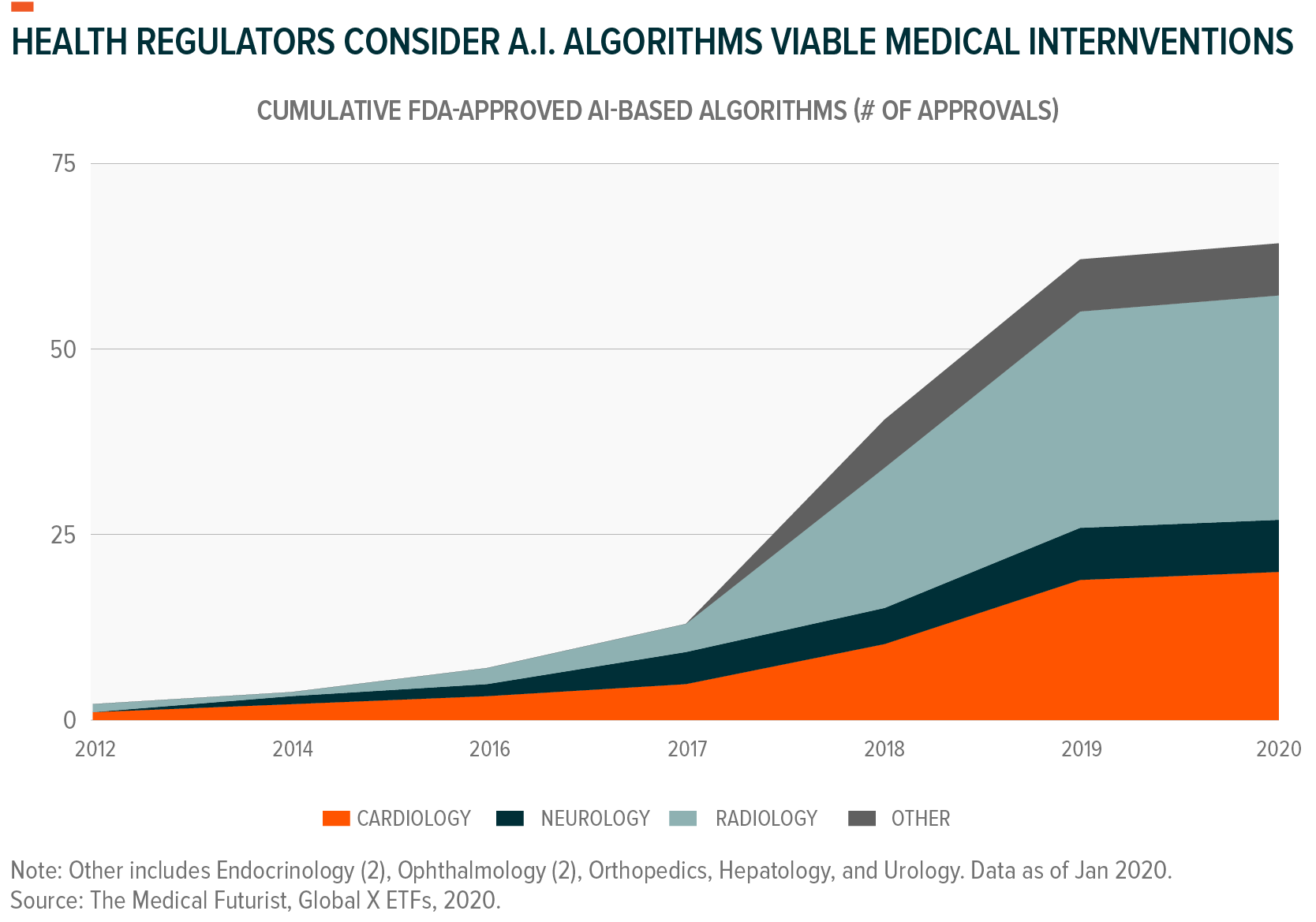
Making Health Care Systems More Intelligent
Health systems are most effective when they deliver optimal health outcomes in an efficient manner. Yet across the globe, many health systems are struggling in both achievement areas. In high-income countries, 1 in 10 patients is harmed receiving hospital care, and 50% of those incidents are preventable.28 In the US, approximately 30% of health care spending could be considered wasteful, annually amounting to between $760 billion to $930 billion.29 With ageing populations increasing demand for health services and costs rising faster than inflation, technology-driven health solutions may present the best remedy to these shortcomings.
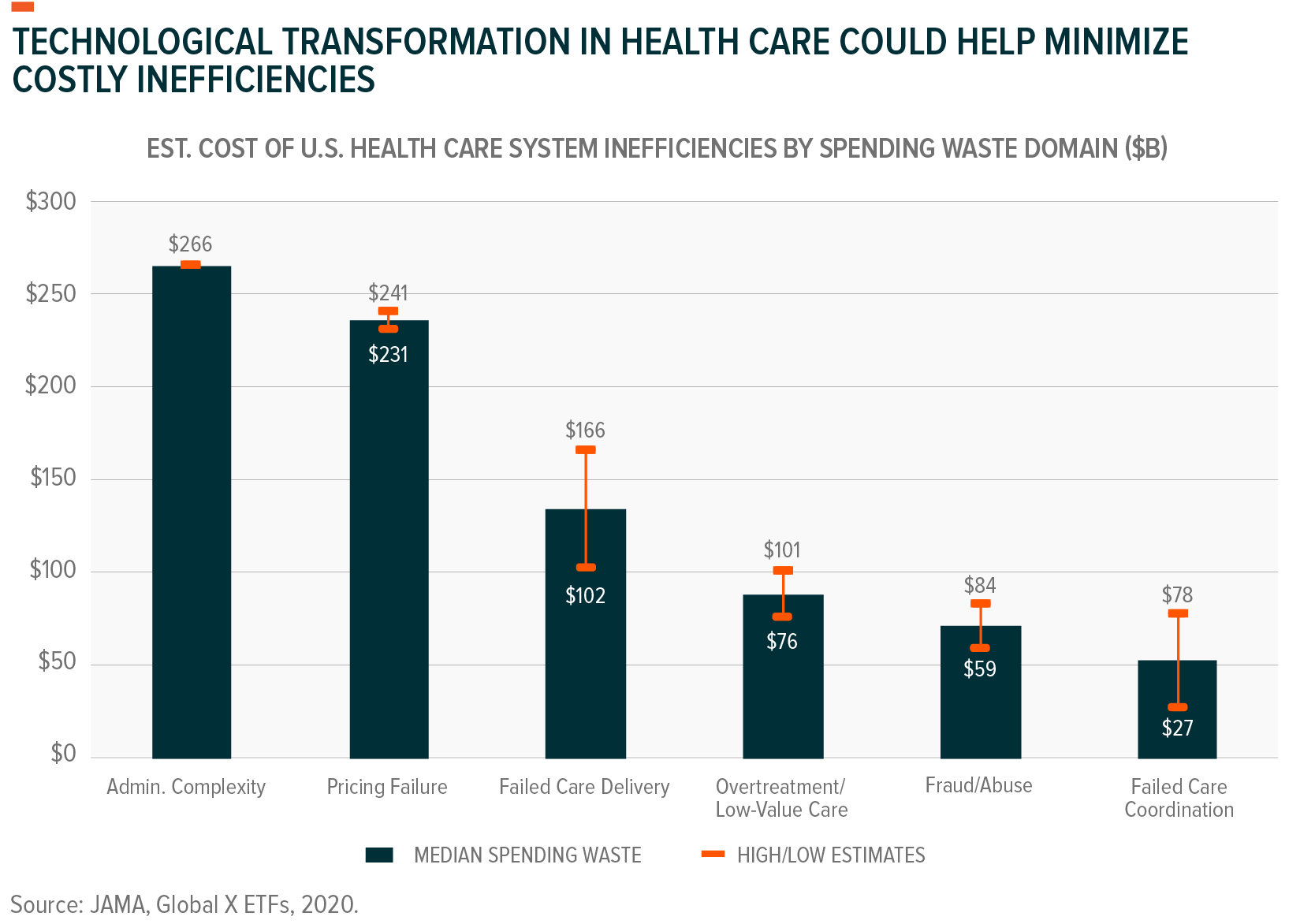
Health care administration is one area where digitization could improve efficiency by reducing administrative overhead and enhancing record keeping processes. Decades-long efforts to digitize health records mean that up to 96% of hospitals and 86% of physicians utilize electronic health/medical records (EHR/EMR).30 Because of these efforts, health systems produce as much as 30% of all electronic data.31 However, 80% of that data is unstructured, meaning it isn’t organized/formalized, and the remaining, structured 20% lacks standardization, with an estimated 5-10% of all health care data coming from duplicate records.32,33 These characteristics present issues when it comes to accurate data querying, processing, and the seamless sharing of data between health stakeholders, or “interoperability.” In many cases, poorly implemented digitization creates complex administrative tasks that misallocate resources.
Herein lies a significant opportunity for modern health tech intervention. AI can parse through unstructured data like scanned freehand doctors’ notes, convert it to digital text, and derive meaning from it. Amazon Web Services, for example, successfully uses machine learning natural language processing algorithms to this end.34 Other health care IT services can make problematic legacy data interoperable, formatting it in-line with standards that allow for compatibility across digital health platforms, devices, jurisdictions, and data exchange mediums. One such standard, HL7’s Fast Healthcare Interoperability Resources (FHIR) is widely regarded as a significant step in making the vast trove of global health care data useful.35 While much of legacy data needs to be converted to meet these standards, most modern connected medical devices and health services yield data that is already interoperable.
Integrated digital health platforms serve as repositories for patient data, clinical data, and genomic data, allowing stakeholders to exchange information that enables better care and optimizes processes.36 Assuming free-flowing and interoperable data, health providers can leverage these platforms and AI-processes to understand the general health needs of their local populations so they can allocate resources accordingly. Spain’s Grupos de Morbilidad Ajustados (GMA) system is good example of this, with decision makers using predictive modeling and health care demand-forecasts derived from local comorbidity data to identify at-risk populations and make budgeting decisions.37 Access to health data beyond the local purview can give providers and other stakeholders an idea of possible or impending health scenarios. For example, AI can process data from global information systems, cell phones, and digital health portals to help health officials successfully detect and curb the spread of communicable diseases.38
Effective use of health care data can address other inefficiencies like pricing failure. In the 2010s, it cost an average $1.8 billion to bring a new drug to market.39 Over time, these costs trickle down to the end recipients of such drugs, possibly disincentivizing patients from taking necessary medications. Digital health platforms and systems can reduce these costs by using AI in drug discovery to streamline the pharmaceutical research and development process.40 And after drug discovery, connected medical devices and wearables can enhance clinical trials through real time monitoring of treatment efficacy.41
With health care data volumes expected to grow at a 36% compound annual growth rate (CAGR) between now and 2025, we expect these tools to significantly and effectively mitigate many of the above mentioned inefficiencies and sub-optimal outcomes in health care.42 We also anticipate that telemedicine and other forms of virtual care will become preferred solutions for health providers as they eliminate much of the inefficiency in-person visits present – McKinsey & Company estimates that approximately $250 billion of all U.S. outpatient and office visit spend could be virtualized.43
Conclusion
Telemedicine and Digital Health can expand access to health care by making it more geographically and financially accessible, presenting opportunities for large scale adoption. Additional opportunity lies in the technologies’ potential to revolutionize treatment options, improve patient outcomes, and streamline health care systems.
In our view, companies that offer services that connect physicians and patients over digital mediums will benefit from the rise of this theme, as will those that develop connected health care devices, operate in the health care analytics space, and/or the administrative digitization segment.
Related ETF
EDOC: The Global X Telemedicine & Digital Health ETF seeks to invest in companies positioned to benefit from further advances in the field of telemedicine and digital health. This includes companies involved in Telemedicine, Health Care Analytics, Connected Health Care Devices, and Administrative Digitization.
Click the fund name above to view the fund’s current holdings. Holdings subject to change. Current and future holdings subject to risk.
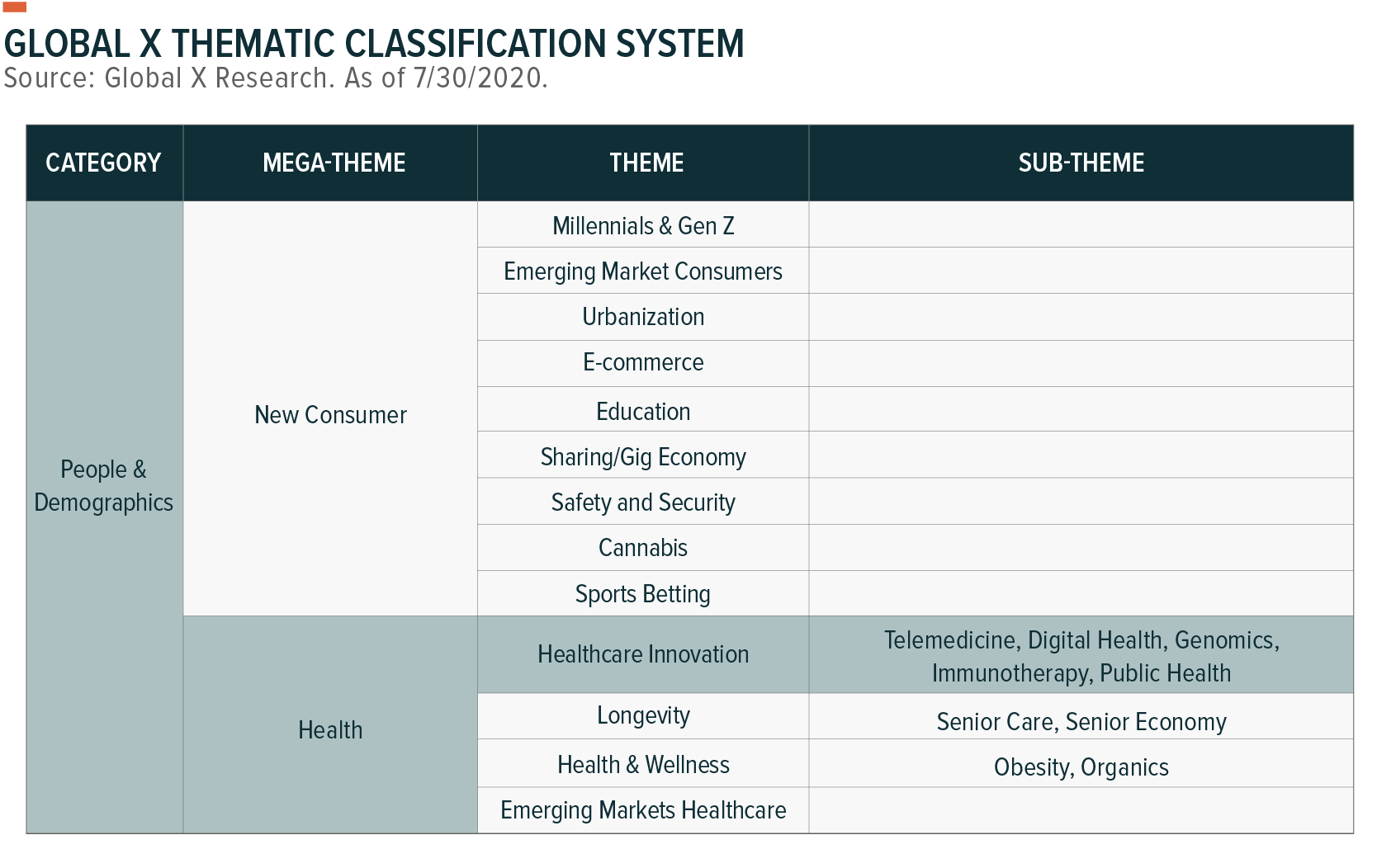
 Global X Research Team
Global X Research Team